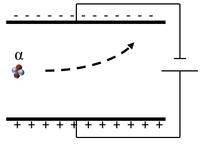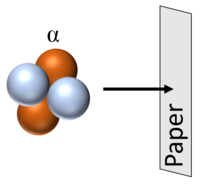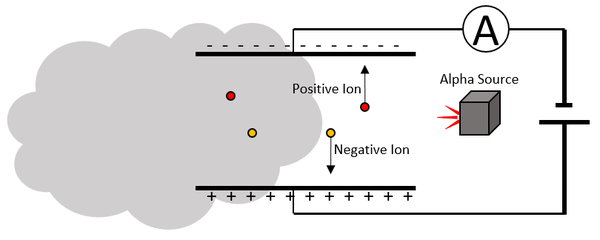Contents
Key Stage 4
Meaning
An alpha particle (α-particle) is a type of ionising radiation made of 2 protons and 2 neutrons emitted from the nucleus of an unstable isotope.
About Alpha Particles
- Alpha particles may also be referred to as alpha radiation and is written with the symbol α.
- Alpha particles are a Helium nucleus.
- Alpha particles have a relative atomic mass of 4 and relative charge of +2.
- Alpha particles are emitted when a nucleus is too large or the ratio of protons to neutrons is too large.
- Alpha particles are emitted rather than single protons or neutrons because the Helium nucleus is extremely stable.
Charge and Mass
| Scientist were able to determine the charge and mass of α-particle by sending it between two electrically charged plates and observing its path.
The α-particle moves towards the negative plate, so it must be positively charged. The rate of curvature depends on the mass:charge ratio which indicates it has a relative atomic mass of 4 and relative charge of +2. |
Penetration Depth
| Alpha particles can travel around 5cm through air (STP) before colliding with and ionising atoms or molecules. |
| Alpha particles can be stopped by a thin sheet of paper. |
Ionising Potential
- With a charge of +2, α-particles are the most ionising of the three ionising radiations. It is capable of removing two electrons from a single atom or molecule or removing 1 electron from two atoms or molecules.
| When an α-particle interacts with an atom the α-particle can remove one or two electrons to ionise the atom. |
Precautions
- Alpha radiation is the most ionising but the least penetrating.
- Outside the body an organism can be protected from alpha radiation by keeping a distance greater than 5cm or by covering any bare skin.
- When handling a source of alpha radiation the precautions which should be taken are:
- Wear gloves
- Use tongs to handle the source, never touch it.
- Aim the source away from any living organism.
- Store the source in a sealed container.
Applications
| In a smoke detector alpha particles are released between two electrodes.
When the alpha particles ionise the molecules in the air the ions move between the electrodes and a current flows in the circuit. When smoke gets between the electrodes the ions become stuck in large particles of soot preventing them from moving. This stops the current in the circuit. The ammeter in the circuit is connected to an alarm which goes off when there is no current. |




